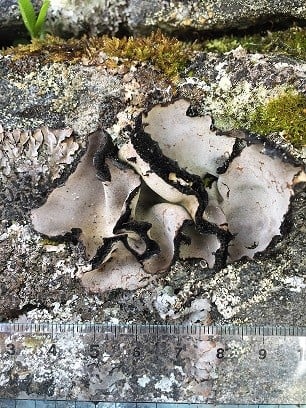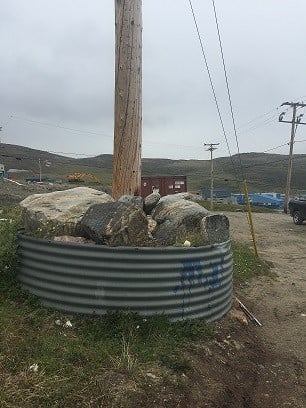Salluit, characterized as tundra environment has permafrost (permanent frozen soil); short summers with almost continuous daylight; long winters and ‘Arctic nights’; low annual precipitation; strong wind and winter blizzards; discontinuous vegetation; and unstable, wet soil conditions resulting from permafrost melt and frost action.
Since it was in the second week of July, the peak of Salluit’s short summer, the morning came with clear skies and moderate chilly wind. We began scouting the surrounding hills, looking for interesting locations. My professor usually said, ‘the nature is our best teacher’, and inspired by the quote, we set on our initial search on the nearby easten hill slope of Salluit.
My goal was to collect interesting rock tripe lichens. The Umbilicaria lichen, known as rock tripe, is a biological composite of Umbilicaria fungi, and photosynthetic partners like algae and, cyanobacteria.
From distant, the hill slope looked easy to climb, however, once I begun, the ground covered with tussocks (grass clumps) was wet with swampy patches was a challenge for me. On my way uphill, a barren-ground caribou ran towards us, it was chased by 3 Inuit dogs (cross-breed between Germany Shepard and Siberian Huskies). Caribou in the northern Nunavik Canada are classified as tundra Barren-ground caribou, and they feed on lichens, particularly favouring the frutiose “reindeer moss” lichens.
Up onto the rocks, there covered sparsely by diversity of lichens and pouches of bryophytes. Dripping waters from thawing ice from the soil flow between and onto some of the rocks. After minutes of scouting the area, we came upon interesting rock tripe thalli sizes. The thalli sizes were strikingly differed in sizes, and were found at habitats differed by presence or absence or water. Using a flame-sterilized knife, thalli were cut at the root and placed into sterilized Whirl-Pak bags.
Once back at the research station (on the way back seeing a cute Lemming rat), a power-post stand close to the Research Station had supporting rock that was covered by rock tripe. The site being located near road, and accessible to human activities was labelled as ‘human impacted’ rock tripe specimens.
Merry Sailonga Faluaburu

Rock tripe found on shaded location.

Power post surround by rocks that had rock tripe growing on it




